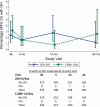Effects of Vitamin D Supplementation on Orthostatic Hypotension: Results From the STURDY Trial
- PMID: 34537827
- PMCID: PMC8807156
- DOI: 10.1093/ajh/hpab147
Effects of Vitamin D Supplementation on Orthostatic Hypotension: Results From the STURDY Trial
Abstract
Background: Vitamin D3 supplementation is considered a potential intervention to prevent orthostatic hypotension (OH) based on observational evidence that vitamin D levels are inversely associated with OH. With data from The Study to Understand Fall Reduction and Vitamin D in You (STURDY), a double-blind, randomized, response-adaptive trial, we determined if higher doses of vitamin D3 reduced risk of OH.
Methods: STURDY tested the effects of higher (1,000+ IU/day, i.e., 1,000, 2,000, and 4,000 IU/day combined) vs. lower-dose vitamin D3 (200 IU/day, comparison) on fall risk in adults ages 70 years and older with low serum 25-hydroxyvitamin D (25(OH)D, 10-29 ng/ml). OH was determined at baseline, 3, 12, and 24 months by taking the difference between seated and standing blood pressure (BP). OH was defined as a drop in systolic or diastolic BP of at least 20 or 10 mm Hg after 1 minute of standing. Participants were also asked about OH symptoms during the assessment and the preceding month.
Results: Among 688 participants (mean age 77 [SD, 5] years; 44% women; 18% Black), the mean baseline systolic/diastolic BP was 130 (19)/67 (11) mm Hg, serum 25(OH)D was 22.1 (5.1) ng/ml, and 2.8% had OH. There were 2,136 OH assessments over the maximum 2-year follow-up period. Compared with 200 IU/day, 1,000+ IU/day was not associated with seated, standing, or orthostatic BP, and it did not lower risk of OH or orthostatic symptoms.
Conclusions: These findings do not support use of higher doses of vitamin D3 supplementation as an intervention to prevent OH.
Clinical trials registration: Trial Number NCT02166333.
Keywords: blood pressure; hypertension; orthostatic hypotension; trial; vitamin D3.
© American Journal of Hypertension, Ltd 2021. All rights reserved. For Permissions, please email: journals.permissions@oup.com.
Figures



References
-
- Rutan GH, Hermanson B, Bild DE, Kittner SJ, LaBaw F, Tell GS. Orthostatic hypotension in older adults. The Cardiovascular Health Study. CHS Collaborative Research Group. Hypertension 1992; 19:508–519. - PubMed
-
- Ooi WL, Hossain M, Lipsitz LA. The association between orthostatic hypotension and recurrent falls in nursing home residents. Am J Med 2000; 108:106–111. - PubMed
-
- Soysal P, Yay A, Isik AT. Does vitamin D deficiency increase orthostatic hypotension risk in the elderly patients? Arch Gerontol Geriatr 2014; 59:74–77. - PubMed
-
- Annweiler C, Schott AM, Rolland Y, Beauchet O. Vitamin D deficiency is associated with orthostatic hypotension in oldest-old women. J Intern Med 2014; 276:285–295. - PubMed
Publication types
MeSH terms
Substances
Associated data
Grants and funding
LinkOut - more resources
Full Text Sources
Medical

